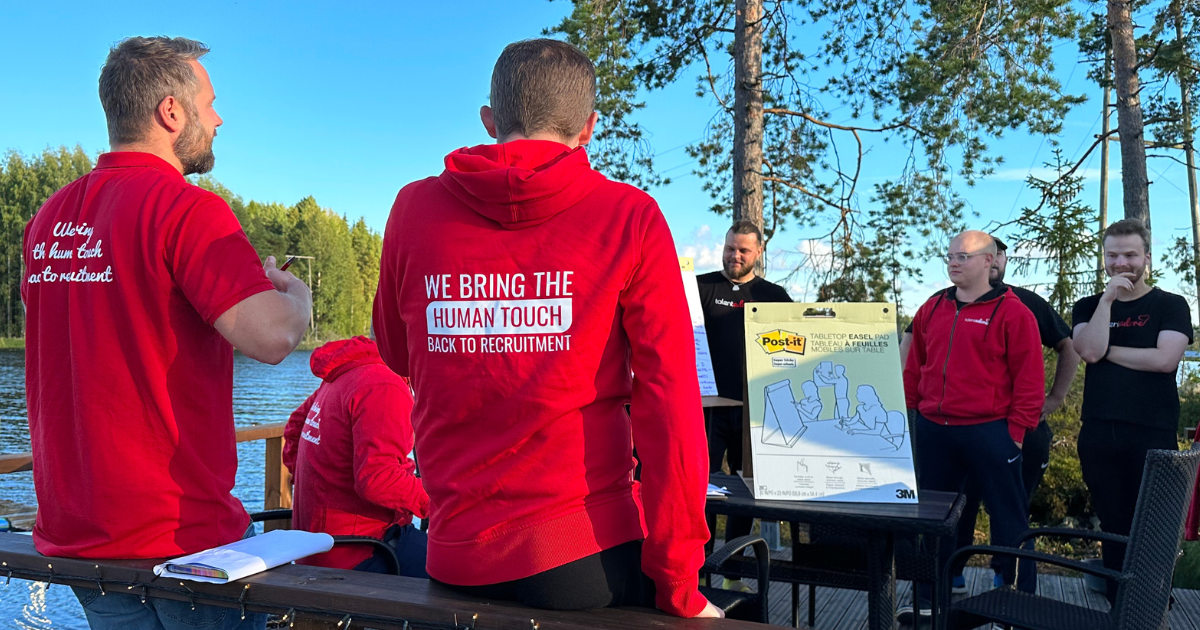Janne Malmisaari
Marketing Manager
In addition to his marketing expertise, Janne has 5 years of experience from talent acquisition for multiple industries.

Inside TalentAdore
Ah, that feeling of stepping to your new workplace for the first time: excitement, anticipation and energy - also some nervousness, doubts even. We’ve all experienced it.
When you begin the next chapter in your career you’re out to prove your employer that they made the right choice. But it goes both ways – the employer needs to back their sales pitch and provide the necessary support and tools for you to succeed.
A crucial part of that is onboarding. And that is something we at TalentAdore have wanted to focus on from the early days of our company.
How do we aim to create a comprehensive and inclusive onboarding experience where all new employees have a soft landing to their role and organization? And most of all: how do we ensure that they feel like they are part of the TalentAdore one-family from day one?
Let our Head of People & Culture Eliza and our team members tell it to you themselves!
What worked for a startup of 10 people doesn’t work for an organization that consists of 40+ people in different cities – even abroad.
Our Head of People & Culture Eliza Elskena has been at TalentAdore for five and a half years at the time of the writing of this blog. Eliza’s journey started in our customer success team, but her passion for people and organization development led to her taking on additional Human Resources -related responsibilities.
This then led to transitioning into her current full-time positions as our Head of People & Culture – a prime example of our culture of continuous development. In her current role, Eliza has been responsible for developing TalentAdore’s onboarding experience.
– When I started working at the company, the onboarding resembled a “sink or swim” approach, where the new team members had to figure out what they are supposed to do and what support they need. Gradually, we started crafting our onboarding process, Eliza notes.
– My key learning from this process is: what worked for a startup of 10 people doesn’t work for an organization that consists of 40+ people in different cities – even abroad. Succeeding as a growth company requires constant innovation and finding ways to execute processes faster and more efficiently than before.
This rings true when it comes to designing onboarding processes as well.
 Whenever repetitive onboarding content is identified, it is essential to make time for documentation and standardization. At TalentAdore we have achieved this by supplementing video recordings and written materials with Q&A sessions. This approach ensures unified experiences of the new hires and more time for other things that matter.
Whenever repetitive onboarding content is identified, it is essential to make time for documentation and standardization. At TalentAdore we have achieved this by supplementing video recordings and written materials with Q&A sessions. This approach ensures unified experiences of the new hires and more time for other things that matter.
As the headcount grows it becomes crucial to develop tools and practices that enable new team members to gain a comprehensive understanding of the whole organization. In practice, this translates not only to clear organization charts, but also to coffee chats and meetings with the representatives of each function.
– Gradually, more people than just HR and team leads are getting involved in the onboarding. We believe that a successful onboarding is a joint-effort between all stakeholders, thus, direct peers and colleagues from other departments contribute to the process by sharing their subject matter expertise.
A good onboarding process acknowledges the differences between various talents and caters to their needs.
Onboarding done right can inspire new employees and accelerate their learning, whereas a bad onboarding can lead to the dreaded information overload, doubts and sense of insecurity.
– Most companies aren’t great at keeping the energy and excitement alive between hiring and the first day of work. We feel that it is important and, therefore, are developing in this area too. The communication can be light in nature – it is the thought that counts. Also, providing pre-onboarding material can help with the information overload at the beginning.
– Candidate engagement is the heart and soul of our ATS solution, so we need to practice as we preach, Eliza reminds.
Once it’s time to welcome the new team member, we aim to provide a smooth landing to the organization. The first two weeks have a clear schedule that employees can follow so they can just “enjoy the ride” and get accustomed to the team, the culture and their new role. Throwing everything at once to the new hiree is counter-productive – there needs to be a systematic approach and as an employer you need to identify a logical learning path.
– While unified processes are necessary to scale, certain flexibility must persist. A good onboarding process acknowledges the differences between various talents and caters to their needs, says Eliza.
During the recruitment process, we put large emphasis on two-way discussion about the candidates’ suitability to our culture. We believe in candidates making well-informed decisions, thus, we provide them with a significant amount of information throughout the recruitment process. A comprehensive info package is sent to candidates already after the first exploration call.
– While culture isn’t something that can be captured in writing easily, our Culture Handbook, created 4 years ago, is our best attempt to do so. From the very early stages we realized the need to define our unique value proposition – as a reminder of who we are and who we strive to be, Eliza tells.
The same focus on culture pertains through onboarding; we want people to understand, embrace and contribute to our culture. TalentAdore’s purpose, culture and history is the very first session that all new employees go through at the start of their employment. This helps the new team members to see how they fit into the bigger picture, as well as to understand the unwritten rules and norms.

– Being onboarded hybrid style was a new experience, says our Technical Customer Support Specialist Saila Sinokki.
– Our team is spread out widely in different cities in Finland, so there was no way we could have met every day at the office. My expectation was that I would not see my team members much during my remote working days, and instead those would be filled with individual tasks and self learning which would gradually evolve into independent work mostly.
– Instead, my remote onboarding days were designed so that I got quality 1-on-1 time with all of my team members throughout the first month. I had light onboarding sessions to different aspects of our product and processeses with different individuals, based on their specific expertise. This provided me with a good understanding of what were the strengths of each team member and who I might turn to with different types of problems in the future, Saila details.
TalentAdore wants to be an employer that makes most of two Worlds: hybrid and physical. The tools and practices need to reflect that. Our Team Member Handbook provides every newcomer with a detailed guidance on these and many other topics.
Naturally, different teams have very different team structures and thus remote cultures, but the overlaying factor is to have open communication as a key value.
– Our CS team has a virtual office-room where people can join from anywhere at any time and work together at the “virtual office”. It’s a good channel for new hires to ask questions and learn from other team members. Other teams have something called “Yes, it’s Friday meeting”, where they share their week’s lows and highs, listen to music, finish work and have afterworks-like atmosphere,” Eliza tells.
While we acknowledge the huge benefits of remote work and want to keep enjoying them, we also recognize the immense value of the human touch. Physical touchpoints at the office enable us to build psychological safety, enhance cross-functional collaboration, onboard new team members and experience the one-family concept by forming a collaborative community and having fun together. In addition to that, our team members have access to co-working spaces around Europe.
What would be Eliza’s message to HR professionals about the importance of onboarding?
– In my opinion, onboarding is a critical part of the employee experience and employer branding. In the light of competing every-day priorities, we tend to postpone important people initiatives until “we will have time” and, thus, many of them never see the light of day. I encourage you to not underestimate the impact of incremental improvements done on a daily basis.
Want to get to know the TalentAdore one-family, learn about our career opportunities? Click here to go to our career pages, explore our culture and evaluate the match! 🤩
Blog
Focus on Interview, Not Scribbling Notes: Meet TalentAdore's AI Notetaker
Blog
From a love letter to a movement: The story behind TalentAdore
Blog
Why the tech team thrives at TalentAdore: A story of autonomy, responsible AI & fixing what’s broken in recruitment
Blog
Bringing the human touch to Customer Engagement